The New York TImes published an article today about Snapchat — the service that lets you send photos and texts that quickly self-destruct as soon as the person you’ve sent them to has seen them. Impermanence is the point.
Before digital (BD), that is in the era of print, photographs were intended to be printed and preserved; indeed that was the whole point — to save a moment in time. And the focus on preservation followed us into the digital era. We are endlessly making back-ups, making sure that everything is always with us. The terminology itself is deeply rooted in the paradigm of print — digital libraries, file systems, folders, etc.
When people started talking about the possibility of media that isn’t frozen at the moment of publication, works that are always in process, a hue and cry went up expressing concern about versions. If there weren’t clearly identified versions people asked, how would we be able to refer to a work and carry on a conversation over time. In response I suggested that future media would be more like life, flowing like a river, always changing, always in motion.
Snapchat which is being adopted quickly by the generation that has grown up with Facebook indicates an historic shift, the upending of preservation as the core issue of future media. The long-term future of discourse will not be dea. intellectual output will flow like streams into rivers. the whole will be much greater than the sum of its parts.
For anyone interested in this subject, I would also recommend David Gelernter’s article in Wired this week. I don’t agree with Gelernter on a lot of things, but in terms of a shift from space-based to time-based reality i think he’s been right on this since he first put it forward in the 90s. The implication is that the long-term future of discourse is not to be divided and frozen into archival versions; rather intellectual output will flow like streams into rivers and the whole will be much greater than the sum of its parts.
Speaking Truth to Power — SocialBook version
a rare opportunity to see change happen
An article in today’s New York Times provides a terrific example of how shifts in the mechanisms of distribution and consumption work over time to produce significant changes in the mode of expression itself.
“House of Cards, which is the first show made specifically for Netflix, dispenses with some of the traditions that are so common on network TV, like flashbacks. There is less reason to remind viewers what happened in previous episodes, the producers say, because so many viewers will have just seen it. And if they don’t remember, Google is just a click away. The show “assumes you know what’s happening all the time, whereas television has to assume that a big chunk of the audience is always just tuning in,” said Ted Sarandos, Netflix’s chief content officer.”
Speaking Truth to Power
I’ve spent much of the past 24 hours reading remembrances of Aaron Swartz as well as a wide selection of his own writing.
We’ve lost an important voice. Not only was he uniquely able to wrap his head around the vast complexity of the emerging digital landscape, Aaron Swartz was generous and brave. He threatened the keepers of the status quo and paid the ultimate price.
Depending on how history turns out, Aaron Swartz may be the first hero of our future age.
For people not familiar with Aaron or the brilliance of his expansive mind I’ve assembled a collection of writings by and about Aaron Swartz.
Back to the Future — In honor of Encyclopedia Britannica giving up its print edition
In 1981 Alan Kay asked me to join him at Atari to continue my work on the idea of an Intelligent Encyclopedia. In order to explain what we were doing to the executives at Warner which owned Atari, I developed these scenarios of how the (future) encyclopedia might be used and commissioned Glenn Keane, a well-known Disney animator to render them. The most interesting thing for me today about these images is that although we foresaw that people would access information wirelessly (notice the little antenna on the device in the “tide pool” image, we completely missed the most important aspect of the network — that it was going to connect people to each other.
Children in the dinosaur exhibit at the Museum of Natural History carry Intelligent Encyclopedia’s with headphones around instead of audiotape players. Interactive simulations of dinosaur life from the IE are running on the wall monitors.

A father reminisces with his son about ’60’s Rock and Roll, calling up footage from the Beatles appearance on The Ed Sullivan Show from the Intelligent Encyclopedia

A vintner in northern California wonders what would be involved in changing wine production to sake. On horseback he is asking the Intelligent Encyclopedia about soil and water requirements for growing rice.
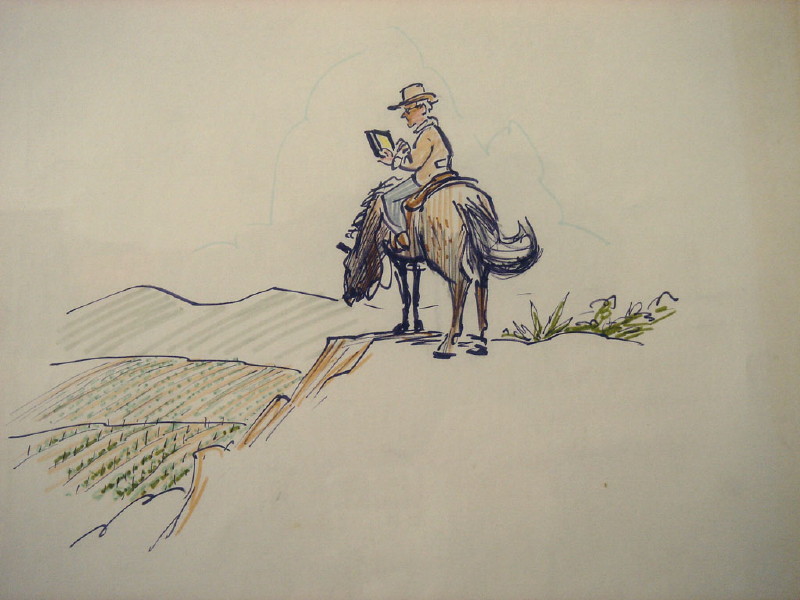
An earthquake wakes a couple in the middle of the night. The Intelligent Encyclopedia, connected to an online service informs them of the severity of the earthquake and makes safety tips readily available.

A third grade class studies various aspects of space travel. The group on the right is running a simulation of a Mars landing while the students on the left are studying a design for a spacecraft.
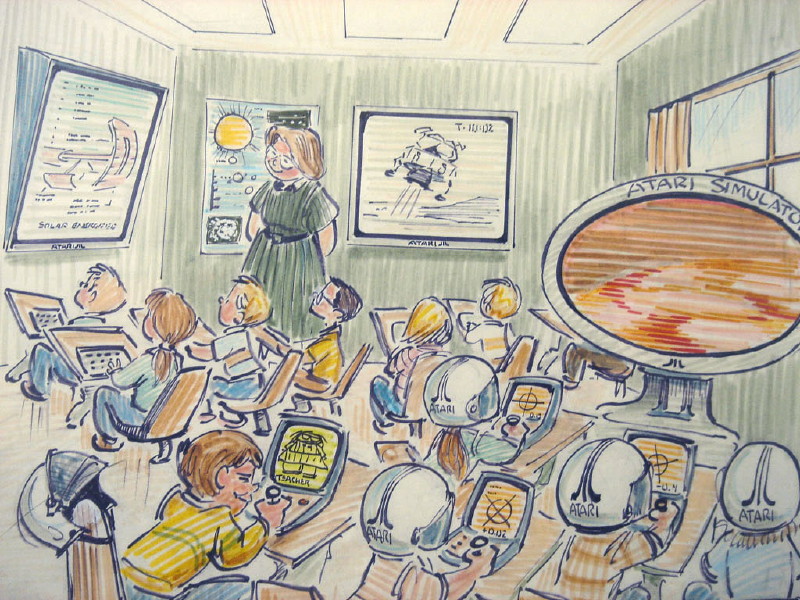
A business man on his way to New York, reviews stockmarket trends.
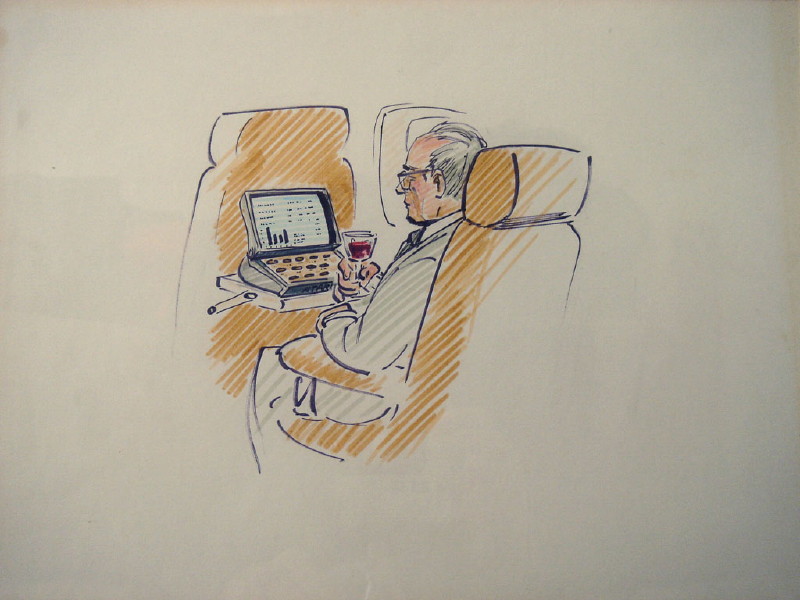
In a bar, the two men at the right are watching football on the screen and running what-if simulations on the countertop Intelligent Encyclopedia which second guess the quarterback. The couple on the left is taking an on-the-spot course in wine connoisseurship.
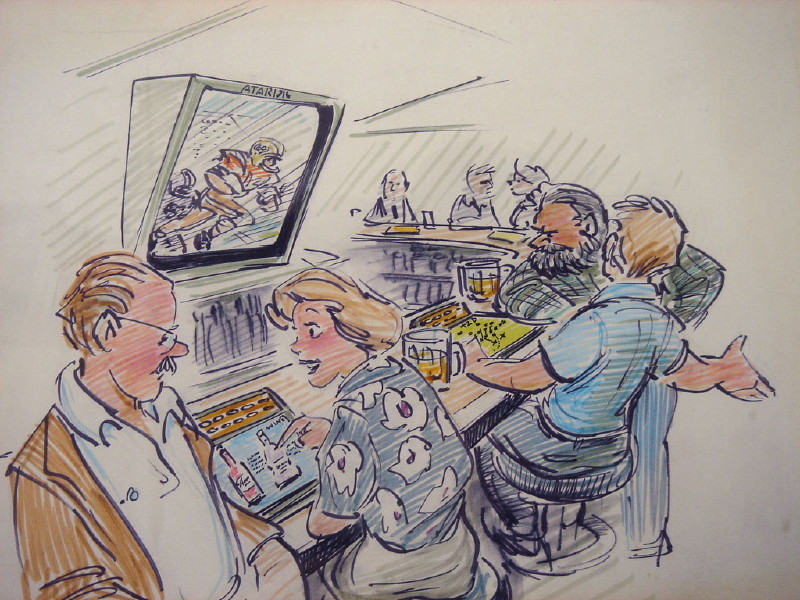
An architect in New York studies Japanese motif for a project he’s working on, while a teacher in Toyo talks with her class about western architectural styles.
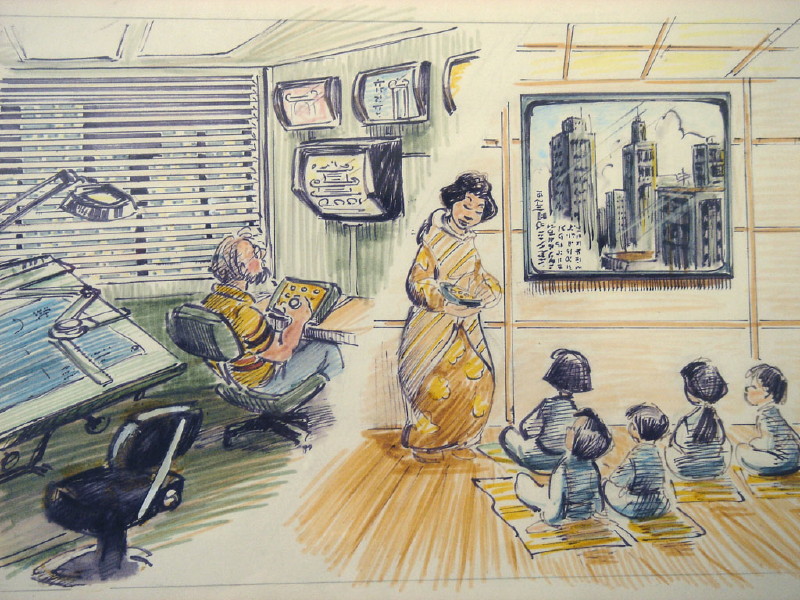
A mother and her children looking into a tidepool in Laguna ask the Intelligent Encyclopedia about the plants and animals that they see. [Notice the antenna for cellular communication.]
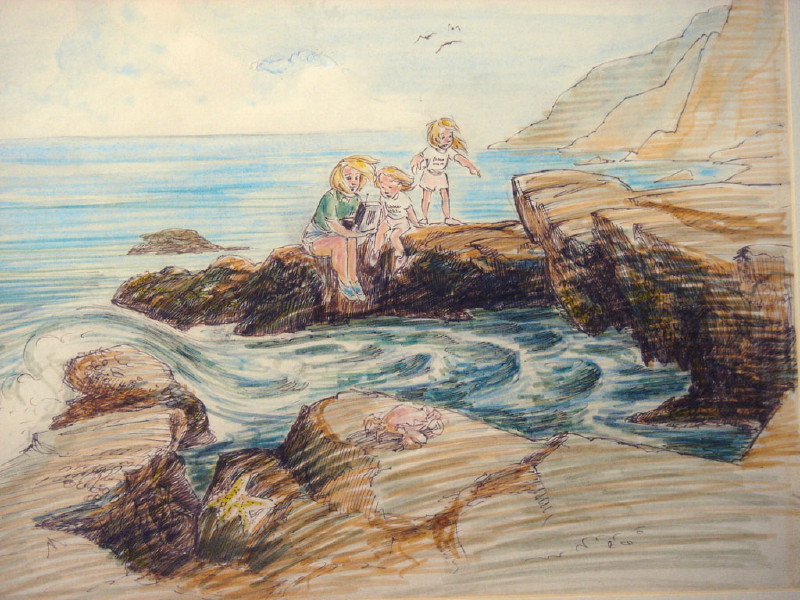
Mobility Shifts Conference at The New School
I think this is going to be a terrific conference.
MobilityShifts: An International Future of Learning Summit
The New School in NYC
October 10-16, 2011
The New School presents the second event in its Politics of Digital
Culture conference series “MobilityShifts: An International Future of
Learning Summit.” Comprised of a conference, hands-on workshops, project
demonstrations, exhibitions and a theater performance featuring youth
and educators from New York City and Chicago, MobilityShifts is a
week-long summit in October 2011. MobilityShifts makes unexpected
international connections between the theories of Jacques Rancière and
Ivan Illich, learning projects outside the bounds of schools and
universities, mobile platforms, and the Open Web. Stop, reflect, listen,
discuss, and build with artists, media scholars, policy makers,
students, technologists, teachers, librarians, legal scholars and
learning activists from 21 countries.
http://mobilityshifts.org/conference/program/
REGISTRATION
To attend MobilityShifts you must register.
The early bird rate ends on September 15th.
http://www.mobilityshifts.org/register1
Participants include: Eduardo Ochoa, Hal Plotkin, Cathy Davidson,
Michael Wesch, Oliver Grau, Mimi Ito, Henry Jenkins, Anya Kamenetz,
Geert Lovink, Shin Mizukoshi, John Palfrey, Irit Rogoff, Juliana Rotich,
Benjamin Bratton, Katie Salen, Shveta Sarda, Molly Steenson, Elizabeth
Losh, Tony Conrad, Lev Manovich, Torsten Meyer, Jan Schmidt, Tomi
Ahonen, Beth Coleman, John Willinsky, Siva Vaidhyanathan, Alexander
Halavais, Giselle Beiguelman, David Carroll, Tania Bustos, Kate
Crawford, Chris Csikszentmihalyi, Sean Dockray, Rolf Hapel, Juan Manuel
Lopez Garduno, Daria Ng, Chris Lawrence, Josie Fraser, David Theo
Goldberg, Marisa Jahn, Sam Gregory, Shravan Goli, Manu Kapur, Edward
Keller, Eric Kluitenberg, Jairo Moreno, Michael Pettinger, Michael
Preston, Daniela Rosner, Richard Scullin, Ramon Sanguesa, Elaine Savory,
Luis Camnitzer, Nishant Shah, Janek Sowa, Dan Visel, Nitin Sawhney and
many others.
Summit Chair
Trebor Scholz
Co-Chairs: Edward Keller, Elizabeth Losh, Matthew K. Gold, David Theo
Goldberg , Karen DeMoss, Sean Dockray
Producer: Jennifer Conley Darling
Associate Producers: Caroline Buck, Liz Carlson
Selected workshops: http://mobilityshifts.org/workshops/
(Workshops require an additional reservation at no extra cost).
This summit builds on two previous events: Mozilla’s Drumbeat Festival
in Barcelona (2010) and Digital Media and Learning in Los Angeles
(2011). MobilityShifts is sponsored by The John D. & Catherine T.
MacArthur Foundation, The New School and the Mozilla Foundation. We
gratefully acknowledge our partners: American University of Paris,
Carnegie Mellon University, Eyebeam Art & Technology Center,
Goethe-Institut, HASTAC, Japan Society, MetaMute, Prezi, School of the
Art Institute of Chicago, SocialText, UC San Diego’s Sixth College, and
University of Pennsylvania.
in honor of the centenary of marshall mcluhan’s birth
Here are three short clips. And there’s a ton more at this wonderful site, Mcluhan Speaks
1960: “We’re just trying to fit the old things into the new form.”
1968: “There’s no longer any gap between the campus and wall street”
1977: “Another strange effect of this electric environment is the total absence of secrecy”
an observer worth paying attention to
James Bridle continues to be one of the most interesting observer/bloggers about books — both print and not
http://booktwo.org/notebook/items-received-by-post/
add this to the list of future(s) of the book
The Book Xylophone
IDPF meeting in may
Bill McCoy has assembled a mouth-watering schedule of the International Digital Publishing Forum IDPF meeting on 23-24 May during Book Expo in New York. registration info and full program at http://idpf.org/digitalbook2011.
The program includes a special keynote from multiple Hugo and Nebula award-winning best-selling science-fiction authors Neal Stephenson and Greg Bear, who will discuss their experience with The Mongoliad, a ground-breaking project in direct-to-consumer and community-augmented online serial publishing.
Confirmed speakers and session topics include:
“The Year of the eBook” – Abe Murray, Google; Yoshinobu Noma, Kodansha
“Publishers Roundtable” – Dominique Raccah, Sourcebooks; Richard Nash, Cursor/Red Lemonade (formerly of Soft Skull Press)
“Special Keynote: The Mongoliad, Year One – a ground-breaking investigation into the future of publishing” – Neal Stephenson and Greg Bear, Subutai Corporation
“Creating Highly Accessible Interactive Content” – Liza Daly, Threepress Consulting
“International Market Opportunities” – Cristina Mussinelli, Italian Publishers Association;
Ronald Schild, MVB Marketing/German Book Publishers Association
“EPUB 3 First Look” – Bill McCoy, International Digital Publishing Forum
“Update on eReading Devices & Apps” – Mary Tripsas, Harvard Business School; Allen Weiner, Gartner; Mitch Weisberg, Sawyer Business School
“Transforming the Business of Publishing”- Lisa McCloy-Kelley, Random House; Ken Brooks, Cengage Learning; Bob Young, Lulu.com
“Breakthrough Business Models” – Theresa Horner, Barnes and Noble; Justo Hidalgo, 24symbols; TJ Waters, Autography
“Metadata Boot Camp” – Bill Kasdorf, Apex; Mark Bide, Editeur; Beat Barian, Bowker
“Lending of Digital Books” – Peter Brantley, Internet Archive, Erica Lazzaro, OverDrive
“Wrangling the Backlist” – Jonathan Hevenstone and Herve Essa, Jouve Group; Sririam Panchanathan, Aptara
“The Future of Digital Reading and the Business of Digital Publishing” – Masaaki Hagino, Voyager Japan, Inc.; Brad Inman, Vook; Peter Balis, John Wiley
“eBook Production Jumpstart” – Josh Tallent, eBook Architects
“Distribution Update” – Andrew Weinstein, Ingram; Bob Nelson, Baker & Taylor
“The Future of EPUB” – George Conboy, Google; Markus Gylling, DAISY Consortium
“Book Industry Study Group Consumer Research Findings” – Steve Paxhia, Beacon Hill Strategic Services
“Social/Direct Marketing: Case Studies from Publishers and Authors” – Malle Vallik, Harlequin Enterprises, Ltd; Sol Rosenberg, Copia
IDPF Digital Book 2011 is being sponsored by industry giants like Adobe, Aptara, Baker and Taylor, Book Business, Ingram, Innodata Isogen, OverDrive, LibreDigital, MeeGenius, Publishers Weekly and SPi Global.

